Downtilt or Downtilting is the method of effectively adjusting the vertical radiation pattern of the antenna of the base station to direct the main energy downwards and reduce the energy directed towards the horizon. Downtilting can be used to improve the level of coverage close to the site where “nulls” (e.g. coverage holes) may exist due to the effective height of the antenna. Downtilting can also be used to reduce interference caused by reflections or undesired RF propagation beyond a predetermined footprint.
Note that any LTE network will require some degree of system optimization based upon site specific variables. The adjustment of antenna downtilt is one of the principle methods of tuning system performance, therefore the system engineer should consider if the chosen antenna can be downtilted and if so, by how much?
The second method of downtilting that can be used is electrical downtilt. Electrical downtilting can be classified as either fixed or remotely adjustable. Motorola RF heads are manufactured with the industry standard control signal connector to allow for remotely adjustable electrical antenna downtilting.
There is no circuitry on the product road map to take advantage of remotely adjustable electrical downtilting from a central location. With fixed electrical downtilt, the degree of electrical downtilt for an antenna can be specified and ordered directly from the antenna manufacturer. The system engineer should be aware if the installed antenna has an electrical downtilt and if so the degree of downtilt. Thus, the field adjustment of downtilt and therefore vertical radiation are not normally altered.
The system engineer should also remember that the amount of gain in the antenna will have a direct affect both on the physical size of the antenna and the vertical beamwidth. If a low gain antenna is utilized, the vertical beamwidth will be relatively broad and therefore the benefits of downtilting will be minimal.
Benefits of Downtilting.
The main benefits of downtilting are:
- Control range of site.
- Reduce energy at the horizon.
- Maximize effective coverage closer to the site.
- Reduce co-channel interference in adjacent sectors.
Downtilt of Antenna Explanation.
The amount of downtilt depends on the height of the antenna above the ground, the characteristics of the terrain, and the vertical beamwidth of the antenna. Consider a scenario where the height of the antenna above smooth earth is 25 meters, at downtilts of 5º and 2º, the main lobe of the vertical pattern would be at distances of 286 and 716 meters, respectively.

Consider another scenario with the same antenna height, but assume that the subscriber’s antenna height (or terrain) is elevated 5 meters at 230 meters compared to the elevation at the site. A downtilt of 5º would be needed to direct the main lobe of the vertical pattern to this location.

Consider a third scenario with the same antenna height, but assume that the elevation has declined by 10 meters at 1000 meters from the site. A downtilt of 2º would be needed to direct the main lobe of the vertical pattern to this location.
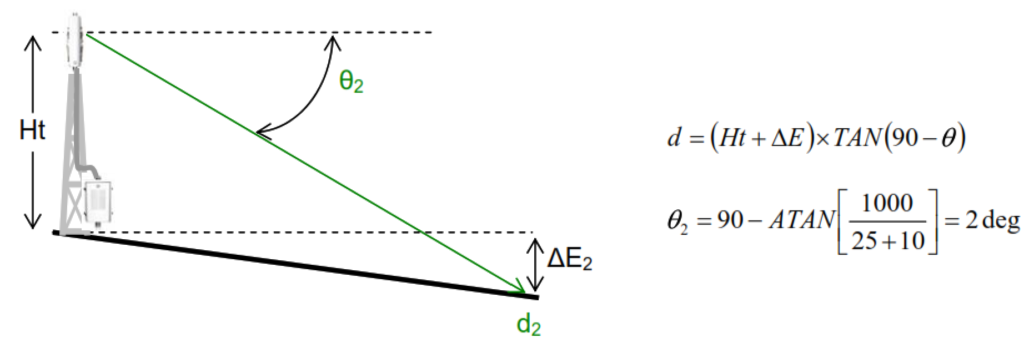
Comparing the second and third scenarios with the first example, it can be seen that the terrain or varying elevations between the transmitter and receiver will have an impact upon the distance observed with the main lobe of the vertical antenna pattern.
The previous examples were focused on the distance from the site that the main lobe of the vertical antenna pattern would fall if downtilted. The actual vertical pattern for the antenna will have various lobes and nulls. Where these nulls occur could potentially cause poor signal levels in a given location. If there are deep nulls (e.g. greater than 15 dB) that exist in the vertical beamwidth, then some further attention may be required to determine where these nulls fall and if they will be of a concern in the RF design.
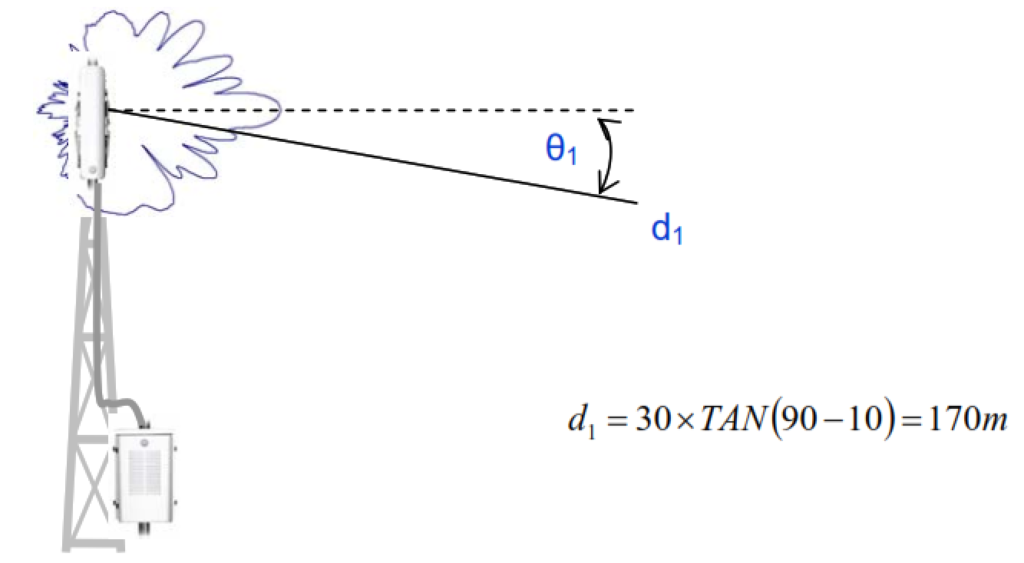
Consider an example where the vertical antenna pattern has a null point at 10 degrees down from horizon of approximately 18 dB down from the main lobe. Assuming a link budget maximum pathloss value of 130.5 dB at the site edge, this value would be reduced to 112.5 dB (i.e. reduction in the pathloss due to the null point) at a distance of 170 meters from the site. To reach the distance of 170 meters assuming the Erceg Greenstein propagation model L(dB) = 43.75 log (dkm) + 124.73.
A pathloss of 91 dB would be required. Thus the first null in the vertical pattern would not have an impact upon the coverage. There may be more than one null in the vertical pattern and some nulls may be deeper.
The following four scenarios provide further illustrations of determining the impact of the nulls on coverage of a site. Each scenario considers the region of the vertical antenna pattern from 0º to 20º down from the horizontal, i.e. includes the first two nulls of the antenna pattern.
Scenario 1 Assumptions:
Hb = 30m, Hm = 1.5m, Environment = Suburban, Terrain = Level and flat, f = 3500 MHz.
Maximum Pathloss = 130.5 dB (from link budget)

Vertical Antenna Pattern with first and second nulls at 10 and 18 degrees, respectively.
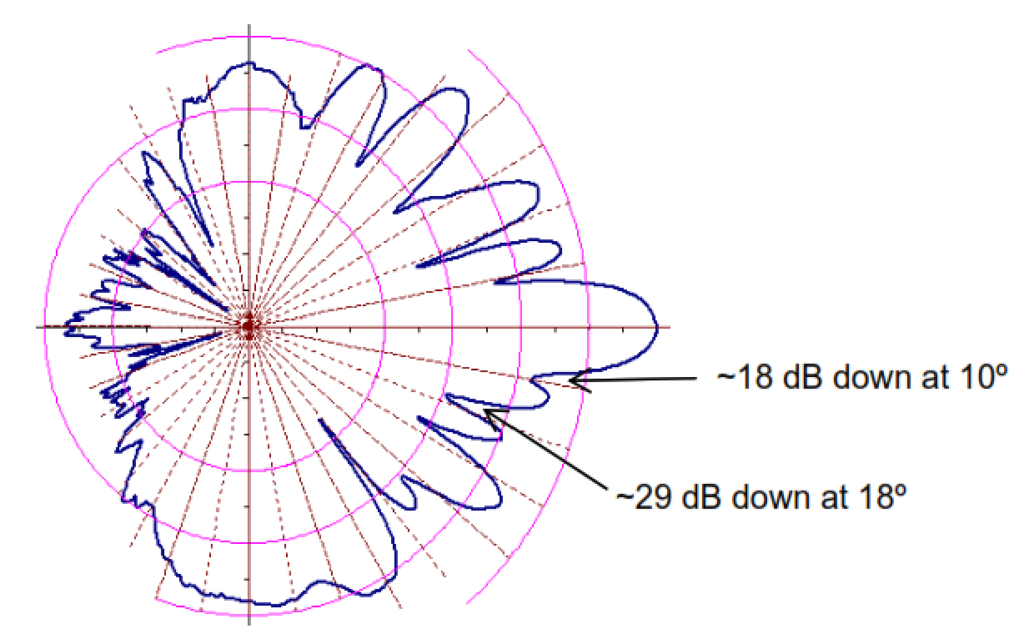
The following graph provides both the pathloss and associated range. The “PL_Ant_Impact” line corresponds to the link budget’s maximum allowable pathloss adjusted by the reduction of antenna gain at the various degrees down from the main lobe. From this line, the nulls located at 10º and 18º can be seen.
The “Range_Ant_Impact” is the distance that results from inserting the “PL_Ant_Impact” pathloss value into the propagation model. The “Range_DT” is the trigonometric result of the antenna height at the various angles from the site. This range is then inserted into the propagation model to determine the “PL_DT_PropMod” pathloss value.
Except for the 1º point, all other points have the “PL_Ant_Impact” pathloss value being greater than the “PL_DT_PropMod” pathloss. This means that the antenna’s vertical pattern will not be limiting the range. The 1º point can be ignored as the link budget’s maximum pathloss places a ceiling on what is allowed.

The two null point locations are analyzed in more detail here for further interpretation of the above chart. At the 10º location,
- The link budget maximum pathloss value would be 112.5 dB (=130.5 – 18) at a range of 286 meters (using the propagation model).
- The antenna height (e.g. 30m), the degree down from the horizon (e.g. 10º) and trigonometry result in a distance of 170 meters, which when entered in the propagation model yields a pathloss of ~105 dB. At the 18º location,
- The link budget maximum pathloss value would be 101.5 dB (=130.5 – 29) at a range of 137 meters (using the propagation model).
- The antenna height (e.g. 30m), the degree down from the horizon (e.g. 18º) and trigonometry result in a distance of 92 meters, which when entered in the propagation model yields a pathloss of ~95 dB.
Scenario 2 Assumptions.
(only changes relative to Scenario 1 are listed):
- Environment Urban

By changing the propagation model, the range arrived through using trigonometry requires a greater pathloss than is available based on the antenna’s vertical pattern impact to the link budget’s maximum pathloss. As these are theoretical results, there may not be any issues seen in the field because of local multipath in the environment.

Scenario 3 Assumptions.
(only changes relative to Scenario 2 are listed):
- Maximum Pathloss 125.5 dB (assume an additional 5 dB of building margin)
Decreasing the maximum allowable pathloss further separates the two different pathlosses as discussed in Scenario 2.

Scenario 4 Assumptions.
(only changes relative to Scenario 2 are listed):
- Antenna downtilted by 4 degrees
By downtilting the antenna at the site, the location of the deep nulls of the vertical pattern is brought in closer to the site to where the improved pathloss can better mitigate the effect of the null. Thus the concern raised in Scenario 2 has been mitigated.

The previous 4 scenarios were a theoretical approach to evaluate the impact of the antenna’s vertical pattern. If the LTE RF system is designed using a propagation prediction application (refer to Section 4.6), the application should be sophisticated enough where the antenna patterns are factored into the prediction.
The following figure illustrates a difference that can be seen with a different antenna height. The image on the right has greater coverage (area of green is larger), but between the 4th and 5th ring the signal level in the right side image is weaker than the left side image. As previously discussed, downtilting the antenna for the 60m case will bring the deep vertical null of the pattern closer to the site where the improved pathloss may mitigate its impact. Thought this will also pull the overall coverage in as well.
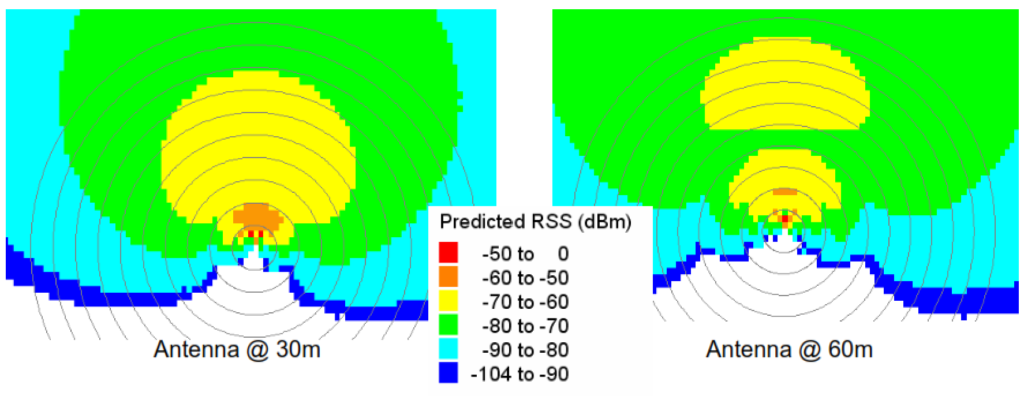
Downtilting is a valuable design option in reducing the coverage of a site and thus improving the CINR, but too much downtilt can be problematic. At a certain degree of mechanical downtilt for the antenna beam, a notch will start to form at the center of the horizontal coverage. The notch will become more pronounced as the degree of downtilt increases. The flattening of the horizontal coverage can be leveraged to reduce interference at a co-channel site, but too much downtilt, as seen by the 10º coverage, will cause a “peanut” effect for the coverage.
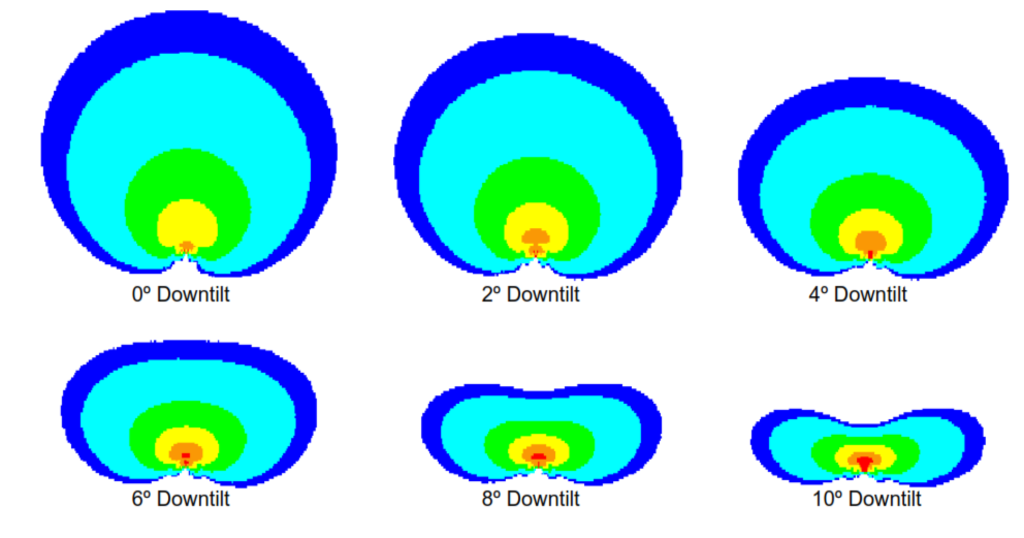
The following figure illustrates the coverage and best server regions for a three sector site with all sectors downtilted by 10º. The sector orientations are represented by the arrows. The ends of the “peanut” coverage for each sector will cause difficulties in achieving good CINR results and also complicate the task of handovers. This 10º of downtilt illustrates that there is a maximum downtilt angle that should not be exceeded, and from the above figure would correspond to approximately ½ of the vertical beamwidth of the antenna.
